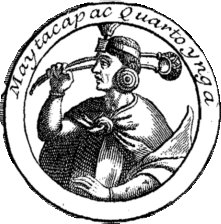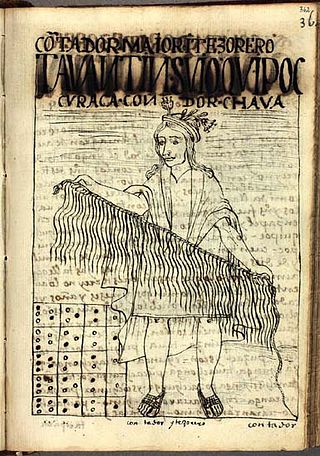
Cajamarca, also known by the Quechua name, Kashamarka, is the capital and largest city of the Cajamarca Region as well as an important cultural and commercial center in the northern Andes. It is located in the northern highlands of Peru at approximately 2,750 m (8,900 ft) above sea level in the valley of the Mashcon river. Cajamarca had an estimated population of about 226,031 inhabitants in 2015, making it the 13th largest city in Peru.

Inca Garcilaso de la Vega, born Gómez Suárez de Figueroa and known as El Inca, was a chronicler and writer born in the Viceroyalty of Peru. Sailing to Spain at 21, he was educated informally there, where he lived and worked the rest of his life. The natural son of a Spanish conquistador and an Inca noblewoman born in the early years of the conquest, he is known primarily for his chronicles of Inca history, culture, and society. His work was widely read in Europe, influential and well received. It was the first literature by an author born in the Americas to enter the western canon.

A chasqui was a messenger of the Inca empire. Agile, highly trained and physically fit, they were in charge of carrying messages –in the form of quipus or oral information– and small packets. Along the Inca road system there were relay stations called chaskiwasi, placed at about 2.5 kilometres (1.6 mi) from each other, where the chasqui switched, exchanging their message(s) with the fresh messenger. The chasqui system could be able to deliver a message or a gift along a distance of up to 300 kilometres (190 mi) per day.

Felipe Guamán Poma de Ayala, also known as Huamán Poma or Waman Poma, was a Quechua nobleman known for chronicling and denouncing the ill treatment of the natives of the Andes by the Spanish Empire after their conquest of Peru. Today, Guaman Poma is noted for his illustrated chronicle, El primer nueva corónica y buen gobierno.

Mayta Cápac was the fourth Sapa Inca of the Kingdom of Cuzco and a member of the Hurin dynasty.

Cápac Yupanqui was the fifth Sapa Inca of the Kingdom of Cusco and the last of the Hurin dynasty.

The Wiphala is a square emblem commonly used as a flag to represent some native peoples of the Andes that include today's Peru, Bolivia, Chile, Ecuador, northwestern Argentina and southern Colombia.

Martín de Murúa, O. de M., was a Basque Mercedarian friar and chronicler of the Spanish conquest of the Americas. He is primarily known for his work Historia general del Piru, which is considered the earliest illustrated history of Peru.

Indian reductions in the Andes were settlements in the former Inca Empire created by Spanish authorities and populated by the forcible relocation of indigenous Andean populations, called "Indians" by the Spanish and "Andeans" by some modern scholars. The purpose of the Spanish Empire was to gather native populations into centers called "Indian reductions", to Christianize, tax, and govern them to comply with Spanish customs and economic interests.
The term Peruvian literature not only refers to literature produced in the independent Republic of Peru, but also to literature produced in the Viceroyalty of Peru during the country's colonial period, and to oral artistic forms created by diverse ethnic groups that existed in the area during the prehispanic period, such as the Quechua, the Aymara and the Chanka South American native groups.

Coricancha, Koricancha, Qoricancha or Qorikancha was the most important temple in the Inca Empire. It is located in Cusco, Peru, which was the capital of the empire.

Blas Valera (1544-1597) was a Roman Catholic priest of the Jesuit Order in Peru, a historian, and a linguist. The son of a Spaniard and an indigenous woman, he was one of the first mestizo priests in Peru. He wrote a history of Peru titled Historia Occidentalis which is mostly lost, although the Inca Garcilaso de la Vega quoted some of it in his General History of Peru. In 1583 Valera was jailed by the Jesuits. The Jesuits claimed they were punishing Valera for sexual misconduct but more likely the reason was heresy. Valera's writings claimed the Incas were the legitimate rulers of Peru, the Inca's language, Quechua, was equal to Latin as the language of religion, and the Inca religion had prepared the Andean peoples for Christianity. In 1596, still under house arrest, he traveled to Spain. He died there in 1597.

El primer nueva crónica y buen gobierno is a Peruvian chronicle finished around 1615. Its author, the indigenous Peruvian Felipe Guamán Poma de Ayala, sent it as a handwritten manuscript to King Philip III of Spain. His purpose was to give a historical account of the Andes from the earliest human beings to the Incas and the Spanish conquest; it was also meant as a call of attention towards the deep problems caused by Spanish government in the region.

The Kingdom of Cusco, also called the Cusco confederation, was a small kingdom based in the Andean city of Cusco that began as a small city-state founded by the Incas around the start of 13th century. In time, through warfare or peaceful assimilation, it began to grow and was succeeded by the Inca Empire (1438–1533).

Pedro de Candia was a Greek explorer and cartographer at the service of the Kingdom of Spain, an officer of the Royal Spanish Navy that under the Spanish Crown became a Conquistador, Grandee of Spain, Commander of the Royal Spanish Fleet of the Southern Sea, Colonial Ordinance of Cusco, and then Mayor of Lima between 1534 and 1535. Specialized in the use of firearms and artillery, he was one of the earliers explorers of Panama and the Pacific coastline of Colombia, and finally participated in the conquest of Peru. He was killed in the Battle of Chupas, (Peru), on 16 September 1542, by Diego de Almagro II.

A yupana is a counting board used to perform arithmetic operations, dating back to the time of the Incas. Very little documentation exists concerning its precise physical form or how it was used.
Pocras were the ancient Wari culture inhabitants of the modern-day city of Huamanga, Peru before the Spanish conquest of the Inca Empire, bounded on the northwest by the Warivilcas, and on the southeast by the Rucanas and the Soras and on the east by the Mayonmarka near the Andahuaylas in La Mar (Chungui) in the current Peruvian province of Ayacucho. This culture was developed in the Middle Horizon and Late Intermediate cultural periods of Peru, from about CE 500 to 1000. Culturally the Pocras were outstanding in pottery, especially that found in Conchopata, Akuchimay, and behind Los Caballitos on the banks of Piñawa, Tenería or contemporary Alameda.

The history of Cusco (Peru), the historical capital of the Incas.

The situa or citua was the health and ritual purification festival in the Inca Empire. It was held in Cusco, the capital of the empire, during the month of September on the day of the first moon after the spring equinox, which in the southern hemisphere takes place normally on September 23. It was a very important festival whose rites are well described by the early Spanish chroniclers, in particular Cristóbal de Molina, Polo de Ondegardo and Inca Garcilaso de la Vega. The latter witnessed situas as a child after the Spaniards had reduced them to memorials of the actual Inca festival. The situa is also mentioned by Bernabé Cobo, who copied, most probably, its text from Molina, Felipe Guaman Poma de Ayala, Pedro Sarmiento de Gamboa and Juan de Betanzos.


















